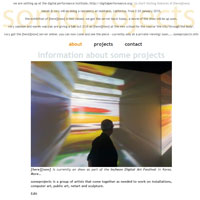 Information about some projects by Marek Walczak, Martin Wattenberg, Rory Solomon, Wesley Heiss, Johanna Kindvall and others will now be documented at1 http://someprojects.info….
Information about some projects by Marek Walczak, Martin Wattenberg, Rory Solomon, Wesley Heiss, Johanna Kindvall and others will now be documented at1 http://someprojects.info….
- test [↩]
 Martin Wattenberg‘s work centers on the theme of making the invisible visible. Past projects include The Shape of Song, Third Person, the Whitney Artport’s Idea Line, and Apartment. Wattenberg is a researcher at IBM, where he creates new forms of data visualization. He is also known for the SmartMoney.com Map of the Market. He holds a Ph.D. in mathematics from U.C. Berkeley.
Martin Wattenberg‘s work centers on the theme of making the invisible visible. Past projects include The Shape of Song, Third Person, the Whitney Artport’s Idea Line, and Apartment. Wattenberg is a researcher at IBM, where he creates new forms of data visualization. He is also known for the SmartMoney.com Map of the Market. He holds a Ph.D. in mathematics from U.C. Berkeley.
See also Bewitched.com
 Information about some projects by Marek Walczak, Martin Wattenberg, Rory Solomon, Wesley Heiss, Johanna Kindvall and others will now be documented at1 http://someprojects.info….
Information about some projects by Marek Walczak, Martin Wattenberg, Rory Solomon, Wesley Heiss, Johanna Kindvall and others will now be documented at1 http://someprojects.info….
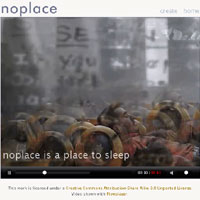 Noplace Online has launched as part of the Tate’s Intermedia series.
Noplace Online has launched as part of the Tate’s Intermedia series.
Whether paradise, heaven or a pessimistic distopia, each of us has a vision like no place on Earth. In noplace you write a few words about that place that has not yet come into being. As your write, your words trigger a set of visual associations, colliding to form a video of your ideal.
LAUNCH
 Noplace Installation premiered as part of Synthetic Times in Beijing, running from June 9 – July 3, 2008. More images from the installation are here
Noplace Installation premiered as part of Synthetic Times in Beijing, running from June 9 – July 3, 2008. More images from the installation are here
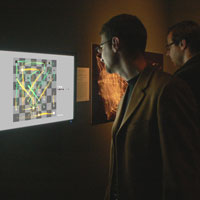 We are pleased to announce that Thinking Machine is currently installed as part of Design and the Elastic Mind at the Museum of Modern Art, New York. The exhibition will run from February 24th to May 12th 2008.
We are pleased to announce that Thinking Machine is currently installed as part of Design and the Elastic Mind at the Museum of Modern Art, New York. The exhibition will run from February 24th to May 12th 2008.
More on Thinking Machines here.
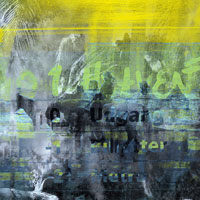 If you are in Amsterdam on Friday 19th October we invite you to the opening of Video Vortex at the Netherlands Media Art Institute
If you are in Amsterdam on Friday 19th October we invite you to the opening of Video Vortex at the Netherlands Media Art Institute
Where we will be showing our work:
Noplace : Heaven
You may enjoy some screengrabs of the piece.
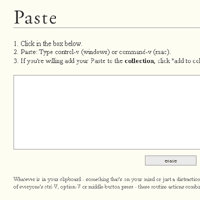 Whatever is in your clipboard, something that’s on your mind or just a distraction, you Paste. Paste keeps track of everyone’s ctrl-V, option-V or middle-button press – these routine actions combine into a single text stream.
Whatever is in your clipboard, something that’s on your mind or just a distraction, you Paste. Paste keeps track of everyone’s ctrl-V, option-V or middle-button press – these routine actions combine into a single text stream.
Paste collects both trivial and profound thoughts creating a continuous scroll. The minutia of collective consciousness forms a shared narrative. A narrative that reflects personal and public history – from the horrors of war to a recipe for mashed potatoes.
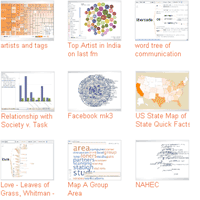 Many Eyes is a bet on the power of human visual intelligence to find patterns. Our goal is to “democratize” visualization and to enable a new social kind of data analysis.
Many Eyes is a bet on the power of human visual intelligence to find patterns. Our goal is to “democratize” visualization and to enable a new social kind of data analysis.
All of us in CUE‘s Visual Communication Lab are passionate about the potential of data visualization to spark insight. It is that magical moment we live for: an unwieldy, unyielding data set is transformed into an image on the screen, and suddenly the user can perceive an unexpected pattern.
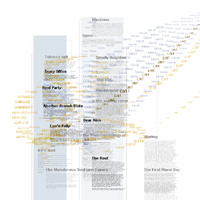 Everyone who has lived in an apartment has a story to tell. Gothamberg is a place to read, interact and exchange stories of lives in apartment buildings. Together, these tales of sounds and smells, lobbies and bathrooms, laundry room gossip and unexpected favors form a single collective building, Gothamberg. Their experiences form the elliptical threads of inhabitation, a mnemonic quality expressing something of the shared nature of dwelling.
Everyone who has lived in an apartment has a story to tell. Gothamberg is a place to read, interact and exchange stories of lives in apartment buildings. Together, these tales of sounds and smells, lobbies and bathrooms, laundry room gossip and unexpected favors form a single collective building, Gothamberg. Their experiences form the elliptical threads of inhabitation, a mnemonic quality expressing something of the shared nature of dwelling.
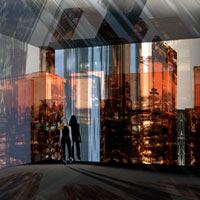 Noplace is an interactive installation and website that aggregates utopias into a shared vision of paradise. We are developing software that collects data, images, and texts via the web and uses these feeds to create virtual architectural structures. These structures expand as utopias are added to the project. In the final installation, projected shadows on the gallery walls represent the architecture that’s evolved from the data, creating a physical browser which viewers can manipulate and transform with a wave of their hands.
Noplace is an interactive installation and website that aggregates utopias into a shared vision of paradise. We are developing software that collects data, images, and texts via the web and uses these feeds to create virtual architectural structures. These structures expand as utopias are added to the project. In the final installation, projected shadows on the gallery walls represent the architecture that’s evolved from the data, creating a physical browser which viewers can manipulate and transform with a wave of their hands.
Noplace has won a Creative Capital Award and is currently under development. More…
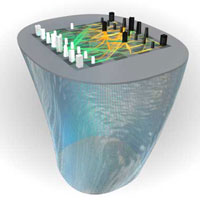 Thinking Table 4 is currently on exhibit at the Banff Center in Canada as part of the show The Art Formerly Known as New Media. In this version two players play against each other using a touchscreen.
Thinking Table 4 is currently on exhibit at the Banff Center in Canada as part of the show The Art Formerly Known as New Media. In this version two players play against each other using a touchscreen.
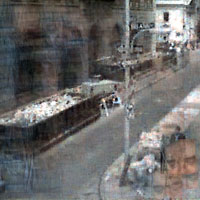 CityCollage creates a leisurely, painterly image of a single second. Your image is used as a palette that echoes the sampling of the artist’s eye. CityCollage takes your photo and uses it to build a streetscape. You become the raw material for an urban construction. As in a city, your own presence is tangential, one ingredient among many. You may not even see yourself, until a sudden moment of recognition, like spotting a familiar face in a crowd.
CityCollage creates a leisurely, painterly image of a single second. Your image is used as a palette that echoes the sampling of the artist’s eye. CityCollage takes your photo and uses it to build a streetscape. You become the raw material for an urban construction. As in a city, your own presence is tangential, one ingredient among many. You may not even see yourself, until a sudden moment of recognition, like spotting a familiar face in a crowd.
Two cameras are trained on two views, one on the street, one in a private space at the installation. Each time movement is detected in the private sphere, a new streetscape is created.
Citycollage was part of the show ‘Urbanisms‘ at the Pace Digital Gallery. More…
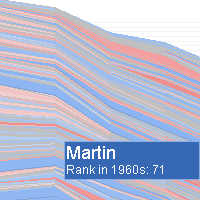 Explore the sea of names, letter by letter…watch trends rise and fall, and dive in deeper to see your favorite name’s place in the historical tides.
Explore the sea of names, letter by letter…watch trends rise and fall, and dive in deeper to see your favorite name’s place in the historical tides.
The Baby Name Wizard’s NameVoyager is an interactive portrait of America’s name choices. Start with a “sea” of nearly 5000 names. Type a letter, and you’ll zoom in to focus on how that initial has been used over the past century. Then type a few more letters, or a name. Each stripe is a timeline of one name, its width reflecting the name’s changing popularity. If a name intrigues you, click on its stripe for a closer look.
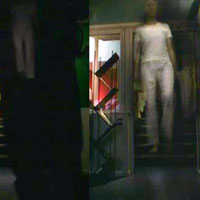 Third person is a temporal mirror. Using camera recognition technology, it replaces realtime video of people at the installation with clips recorded earlier. In the present, people’s movements are ‘averaged’, a little like a Muybridge photo sequence, so that they form the canvas onto which the previous footage then plays.
Third person is a temporal mirror. Using camera recognition technology, it replaces realtime video of people at the installation with clips recorded earlier. In the present, people’s movements are ‘averaged’, a little like a Muybridge photo sequence, so that they form the canvas onto which the previous footage then plays.
People are visible only as dark silhouettes against which, perhaps, you can see a previous clip of a figure in white descending the same staircase.
Third Person was shown at the ICA, London, as well as at LMCC, 4 Walls Film Club and by appointment.
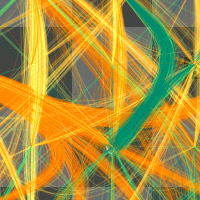 Thinking Machine 4 explores the invisible, elusive nature of thought. Play chess against a transparent intelligence, its evolving thought process visible on the board before you.
Thinking Machine 4 explores the invisible, elusive nature of thought. Play chess against a transparent intelligence, its evolving thought process visible on the board before you.
The artwork is an artificial intelligence program, ready to play chess with the viewer. If the viewer confronts the program, the computer’s thought process is sketched on screen as it plays. A map is created from the traces of thousands of possible futures as the program tries to decide its best move. Those traces become a key to the invisible lines of force in the game as well as a window into the spirit of a thinking machine.
Installation, London ICA, 2003. Ars Electronica 2004. Launch